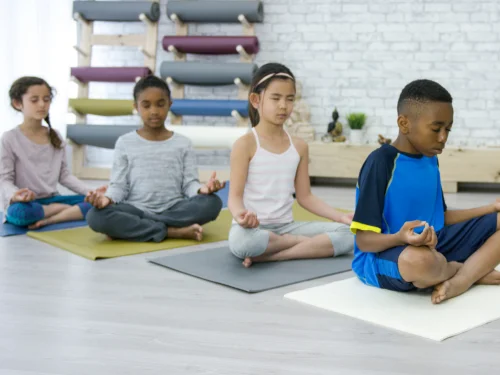When Do Kids Start Reading? Signs, Stages, and How Parents Can Help

Yes—finger plays, clapping games, and dance routines that use hand gestures all help. Combine rhythm and repetition for deeper learning.
Send home simple activity ideas, kits, or worksheets. Offer short instructions and encourage family involvement. Regular practice builds lasting progress.
Try origami, sticker scenes, stringing pasta, or painting with Q-tips. Crafts that use small pieces build precision and control.
There isn’t a single “right age” when kids must learn to read. For many children, the process starts well before school with exposure to stories, songs, and letters.
Most experts agree that by first or second grade (around ages 6–7), kids typically begin reading short books independently. Some children show signs of readiness as early as 4 or 5, while others may take a little longer.
What matters most is not when a child starts but that they receive consistent support to develop their reading foundation. By around third grade (age 8), children are expected to shift from “learning to read” toward “reading to learn” in school.
Why Early Reading Skills Matter

Reading is more than sounding out words—it shapes thinking, communication, and curiosity. Early literacy skills help children:
- Build stronger vocabulary
- Improve comprehension in all subjects
- Develop confidence
- Strengthen imagination and creativity
Early exposure also makes reading feel fun and familiar, not intimidating—setting the stage for lifelong learning.
Signs Your Child Is Ready for Reading
.webp)
Every child develops differently, but there are clear indicators that a child is preparing to read. Look for these milestones:
1. Recognizing Letters and Words
By ages 3–4, many kids begin identifying letters, especially those in their name, and may recognize common signs or logos.
2. Following Conversations
Children who can engage in simple back-and-forth conversations show they have the language skills needed to connect spoken and written words.
3. Phonemic Awareness
Around preschool age, children start making connections between letters and sounds (like knowing that “s” says /sss/). This ability to break down words into sounds is a key reading skill.
4. Interest in Books and Stories
A child who brings you a book, asks to be read to, or pretends to “read” aloud is showing readiness. Interest fuels motivation.
5. Sounding Out Words
Around ages 5–6, many kids begin blending simple sounds into words (like /c/ /a/ /t/ → cat). By first grade, most can decode short words more confidently.
Reading Milestones by Age
.webp)
Here’s a rough guide to what you might expect at different stages:
- Toddlers (2–3): Pretend reading, repeating favorite phrases from books, turning pages.
- Preschool (3–4): Recognizing letters, rhyming, identifying the first sound in words.
- Pre-K to Kindergarten (4–5): Beginning to match letters to sounds, recognizing some sight words.
- First Grade (6–7): Reading short books, sounding out unfamiliar words, starting comprehension.
- Second–Third Grade (7–8): Reading fluently with expression, understanding punctuation, tackling longer texts independently.
What Helps Kids Learn to Read
.webp)
Parents and caregivers play a vital role in nurturing early literacy. Here are a few effective strategies:
- Read Aloud Daily: Even 10 minutes a day builds vocabulary and models fluency.
- Play Sound Games: Rhyming games, “I spy” with sounds, or clapping syllables sharpen phonemic awareness.
- Encourage Print Awareness: Point out street signs, labels, or menus to connect print with meaning.
- Blend Fun with Learning: Letter magnets, flashcards, or simple reading apps keep practice engaging.
- Be Patient: Celebrate progress rather than focusing on speed—reading is a marathon, not a race.
You May Also Like: Force and Motion for Kids: 10 Fun Activities with Pushes, Pulls, and More!
Suggested Reading Activities
.webp)
- Create a bedtime reading routine.
- Use picture books to ask questions like, “What do you think will happen next?”
- Encourage storytelling—have your child make up a story using their toys or drawings.
- Write simple notes or labels around the house for common items (chair, door, bed).
You May Also Like: 8 Social Skills for Kids: Building Strong Connections from the Start
Final Thoughts
So, when do kids start reading? Most children begin between ages 4–7, but the journey is unique for every child. What’s most important is consistent exposure to books, supportive guidance, and encouragement to enjoy the process.
Whether your child starts early or takes a little longer, reading is not a race. With patience, practice, and a playful approach, every child can grow into a confident reader.
You May Also Like: 15 Impulse Control Activities for Kids: Fun Ways to Build Self-Regulation
When Do Kids Start Reading FAQ
1. What are the best coordination drills for kids?
Balloon tap, hopscotch, cross-crawls, bead stringing, and balance beam walking are among the most effective.
2. How can I improve my child’s hand-eye coordination at home?
Use balloon games, beanbag tosses, bubble popping, or simple catching practice.
3. What coordination activities are good for preschoolers?
Animal walks, dance freeze, simple kicking games, and bead threading are ideal.
4. How often should kids practice coordination drills?
Short sessions 3–5 times per week are enough to see improvement.
5. What are good indoor coordination drills for kids?
Twister, scavenger crawls, yoga poses, and mirror moves work well indoors.
6. How do coordination drills support school readiness?
They improve handwriting, attention, sitting posture, and classroom motor tasks.
7. Can coordination drills help kids with ADHD?
Yes—structured movement improves focus, body awareness, and self-regulation.
8. What coordination games can I do with no equipment?
Cross-crawls, marching, freeze dance, and Simon Says require nothing but space.
9. How do I make coordination drills fun for kids?
Turn them into challenges, games, or races; add music; and rotate activities often.
10. Do coordination drills help with sports skills?
Absolutely. Improved balance, timing, and motor control translate directly to better performance in soccer, basketball, biking, and more.




